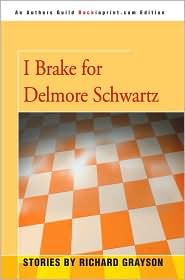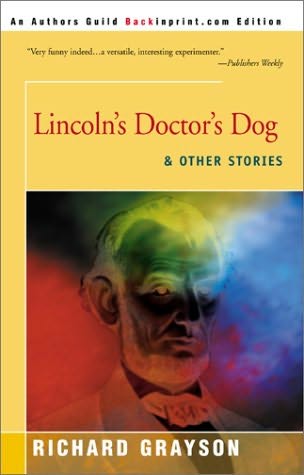
Alvin Rosenfeld's Imagining Hitler, published this year (1985) by Indiana University Press, is, according to the New York Times review of the book "a brief but forceful survey of . . . works of fiction, ranging from books by established authors - George Steiner, Beryl Bainbridge - to pulp thrillers and curiosities such as Richard Grayson's 'With Hitler in New York.'"

Rosenfeld's analysis of "With Hitler in New York" appears on pages 71-73:


. . . Compared to the Wandering Jew, who in most versions of the archetype is pictured as solitary and companionless in his misery, the Wandering Gentile doesn’t have it so bad.
In Richard Grayson’s astonishing story, “With Hitler in New York,” he has it, in fact, pretty good. Grayson gives us a Hitler in blue jeans, who backpacks his way to New York on Laker Airlines to spend some time with his Jewish girlfriend. As the story opens, the narrator is waiting at the airport with Ellen, Hitler’s girl, for the flight to come in. Hitler arrives from Germany wearing a work shirt and leather jacket, and they go off to the city. It’s summertime, and New York is in the grip of a heat wave. They watch T.V., eat ice cream, smoke a joint together. The narrator notes that “Hitler had a nice air about him” and admires the way he moves (“He is so comfortable with his body”). Hitler is jet-lagged and dozes off on the couch. “What do you think of Hitler?” Ellen asks. “I kind of like him,” the narrator says. “I never realized he was so witty.”
As the story progresses, these early good feelings about Hitler increase. “I think I would like to be like him,” the narrator muses. And later, “I wonder if I am beginning to fall in love with him.”
Hitler is uncomfortable in the oppressive heat of New York and is catching a cold, but he doesn’t want to put a damper on things and rallies his spirits. They go off to have breakfast at McDonald’s, watch a movie together on Channel 9, have dinner in the Village. It’s a little like the threesome in Jules and Jim. They gather a fourth, Libby, and go to Washington Square and sit around the fountain. The next day they swim, have dinner at Ellen’s parents’ house (the narrator’s mother “seems to like Hitler,” even if Ellen’s mother doesn’t), walk the boards of Brighton Beach, and eat eggcreams. Nearby some Russian Jews are enjoying themselves singing Yiddish folksongs. Hitler listens intently, understands the slightly bawdy lyrics, then walks off before he can be recognized by the old Jews.
The friendship between Hitler and the narrator deepens as the days pass. As an expression of his affection, Hitler gives the narrator a present, a book of Rilke’s poems.
The remainder of their days together in New York are spent in pretty much the same way. The three friends have dinner together at a Szechuan restaurant in Brooklyn Heights, sample the carrot cake at a healthfood place on Atlantic Avenue, look at the brownstones, joke around.
In the midst of it all, the narrator’s grandfather dies in Florida, but the narrator does not want to skip out on a going-away party for Hitler, who will be flying back to Germany in two days, and does not tell anyone about the death. He feels bad about it, but it’s Saturday night, their time together now is very short, and he joins the other guests at the party.
Hitler is a big hit, holds his beer well, and is as friendly and as witty as can be. The narrator’s admiration has by now turned to love, and it is clear they have become the best of friends. They get drunk and joke about winning the Nobel Prize together, Hitler for Peace, the narrator for Literature. “We would have to wear ties,” Hitler says. “No, tuxedos,” the narrator replies. “And top hats and canes.” They joke some more about doing vaudeville together.
At the story’s end, the narrator confides in his new friend that his grandfather has just died, and begins to cry. Hitler consoles him by telling him funny stories. It helps some, and the narrator drives Hitler home feeling a little better. And there the narrative ends.
Substitute almost anyone else for Hitler, and the story would fail. With Hitler in it, though, it is a fictional tour de force, the furthest extension to date of the neutralization of the historical Hitler and the normalization of a new image of the man. The evil monster is gone, as is the murderous anti-Semite. One neither fears nor loathes this Hitler, for in developing him Grayson has eliminated from his narrative virtually every trace of the Nazi Führer and put in his place a regular guy – likable, affectionate, funny, fun to be with. In costume, manner, taste, and overall affability, he fits in; in fact, he is something of a swinger and the epitome of the late-60s casual style. If one identifies at all with the narrator (and the story is designed to bring about an alignment of the reader’s feelings with the narrator’s), by story’s end one hates to see Hitler go.
It is not difficult to see what Grayson has done in writing his Hitler story, but at the same time it is not easy to know why he has done it or how he wants his readers to understand it. Unlike other fictions that manipulate the survival myth, Grayson has put “With Hitler in New York” under no obligation whatever to explain how Hitler has survived the siege of Berlin and his own suicide and is still around today. The story, in fact, is free of all references to the war years, the Nazi regime, the persecution and murder of the Jews, bunkers and bombs. In all of these respects, the story is unanchored in the history of the Third Reich and without the taint of any of its crimes. If there is any suspicion that this Hitler is sadistic, it is only because he throws his girlfriend around the swimming pool. Otherwise, there is nothing at all brutal or mean-spirited about the man. Were his name not Hitler, indeed, one would not even pause to inquire about the possibilities of a mean streak, for this fellow is a softy, not a sadist.
He is also not an anti-Semite, as his affectionate ways with his Jewish girlfriend show clearly enough. There are indications that the narrator is also a Jew, and yet Hitler and he become the best of buddies. It is true that Ellen’s mother does not take to him, but he gets along well enough with her father and is invited to share a meal at the family table. Hitler’s ways with the Jews are, in sum, by and large natural and easy and bear no resemblance to the mad anti-Semitic passions of the Führer of the Third Reich.
Grayson, one comes to understand, has de-Nazified Hitler, pacified him, and projected him as normative. At some very deep level of the imagination he has removed him from history, recast him in anti-apocalyptic terms, and made him safe to behold. His name and nationality aside, Hitler might as well be someone else, someone one need not fear to touch or tangle with romantically. There are no ironies here, weak or strong, only erasures so complete as to disarm the historical sense altogether and eliminate it as a factor in reading. In its representation of Hitler as a pure fiction, “With Hitler in New York” carries us beyond the transcendental leaps of the religious imagination, beyond the counterfeit claims of the revisionists, beyond the “alternative” possibilities and fictitious endings of popular formula fiction, and into a realm of imagination that all but dissolves historical memory. Whatever its author’s intentions might have been, his story succeeds in showing us just how much is lost when the name Hitler gives up its force and no longer evokes anything of consequence from the past.
“Forgetfulness,” Nietzche wrote, “is a property of all action. . . . One who would feel everything historically would be like a man forcing himself to refrain from sleep, or like a beast who had to live by chewing a continual cud.” The fictions reviewed in this chapter are a diverse lot, but all have in common a will to forgetfulness, a desire or ambition to spit out the historical cud.




































